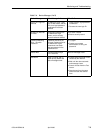
Monitoring and Troubleshooting
7-3
8700-A2-GB20-00
April 2000
Health and Status Messages
The following messages appear in the first column of the System and Test Status
screen. The highest priority Health and Status message also appears on all ATI
screens on the bottom right.
Table 7-1. Health and Status Messages (1 of 3)
Message
What Message Indicates What To Do
AIS at DSX-1,
Pt n
An AIS (Alarm Indication
Signal) is being received by
the DSX-1 interface.
1. Verify that the unit’s line framing
and line coding are compatible.
2. Contact network provider.
AIS at G.703,
Pt n
An AIS is being received by
the G.703 interface.
1. Verify that the unit’s line framing
and line coding are compatible.
2. Contact network provider.
Device Failed
yyyyyyyy
An internal error has been
detected by the operating
software. yyyyyyyy indicates
the 8-digit hexadecimal failure
code.
1. Provide the 8-digit failure code
shown (yyyyyyyy) to your service
representative.
2. Reset the unit to clear the
condition and message.
Download Failed A firmware download was
interrupted.
Repeat the download.
EER at DSX-1,
Pt n
An EER condition has been
detected on the DSX-1
interface.
1. Verify the attached equipment
coding is compatible.
2. Contact network provider.
EER at G.703,
Pt n
An EER condition has been
detected on the G.703
interface.
1. Verify that the network cable is
securely attached at both ends.
2. Verify proper NTU and LTU
configuration.
3. Contact network provider.
EER at Net, Pt n An EER (Excessive Error
Rate) condition has been
detected on the network
interface at Port n. The
condition is cleared when the
error rate falls below the
threshold value currently
configured.
1. Check the Network Performance
Statistics screen for possible line
impairments.
2. Set the unit to run at a lower DSL
line rate.
Fallback Rate,
Pt n
The LTU, set to AutoRate
enable, synchronized at a
lower rate when the line was
restored after an LOS.
Reset AutoRate, or run at a fixed
rate.
IP Mismatch, Pt n The NTU and the LTU are
operating in different NMS
management modes: one is
in IP Conservative mode and
one is not.
In a DSLAM-to-DSLAM
configuration, use the same
software in the management cards
of both DSLAMs.


















